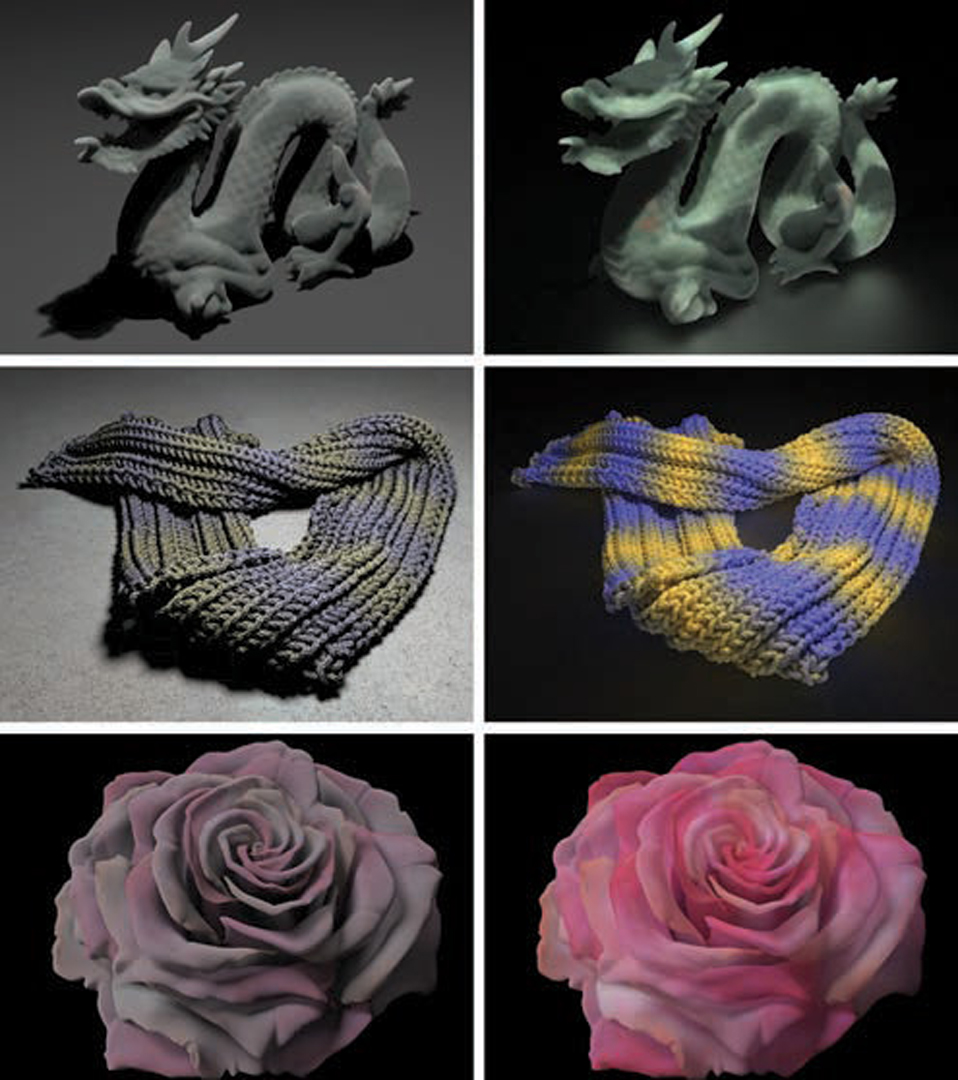“Interactive Albedo Editing in Path‐Traced Volumetric Materials” by Hasan and Ramamoorthi
Conference:
Type(s):
Title:
- Interactive Albedo Editing in Path‐Traced Volumetric Materials
Session/Category Title: Precomputed Rendering
Presenter(s)/Author(s):
Moderator(s):
Abstract:
Materials such as clothing or carpets, or complex assemblies of small leaves, flower petals, or mosses, do not fit well into either BRDF or BSSRDF models. Their appearance is a complex combination of reflection, transmission, scattering, shadowing, and inter-reflection. This complexity can be handled by simulating the full volumetric light transport within these materials by Monte Carlo algorithms, but there is no easy way to construct the necessary distributions of local material properties thatwould lead to the desired global appearance. In this article, we consider one way to alleviate the problem: an editing algorithm that enables a material designer to set the local (singlescattering) albedo coefficients interactively, and see an immediate update of the emergent appearance in the image. This is a difficult problem, since the function from materials to pixel values is neither linear nor low-order polynomial. We combine the following two ideas to achieve high-dimensional heterogeneous edits: precomputing the homogeneous mapping of albedo to intensity, and a large Jacobian matrix, which encodes the derivatives of each image pixel with respect to each albedo coefficient. Combining these two datasets leads to an interactive editing algorithm with a very good visual match to a fully path-traced ground truth.
References:
- Arvo, J. 1993. Linear operators and integral equations in global illumination. In SIGGRAPH Course Notes 42.
- Ben-Artiz, A., Egan, K., Durand, F., and Ramamoorthi, R. 2008. A precomputed polynomial representation for interactive brdf editing with global illumination. ACM Trans. Graph. 27, 13:1–13:13.
- Ben-Artiz, A., Overbeck, R., and Ramamoorthi, R. 2006. Realtime brdf editing in complex lighting. ACM Trans. Graph. 25, 945–954.
- Bouthors, A., Neyret, F., Max, N., Bruneton, E., and Crassin, C. 2008. Interactive multiple anisotropic scattering in clouds. In Proceedings of the ACM Symposium on Interactive 3D Graphics and Games (i3D’08). E. Haines and M. Meguire, Eds., 173–182.
- Dorsey, J. O., Arvo, J., and Greenberg, D. P. 1995. Interactive design of complex time-dependent lighting. IEEE Comput. Graph. Appl. 15, 2, 26–36.
- Igehy, H. 1999. Tracing ray differentials. In Proceedings of the 26th Annual Conference on Computer Graphics and Interactive Techniques (SIGGRAPH’99). 179–186.
- Jakob, W. 2010. Mitsuba renderer. http://www.mitsuba-renderer.org.
- Jakob, W., Arbree, A., Moon, J. T., Bala, K., and Marschner, S. 2010. A radiative transfer framework for rendering materials with anisotropic structure. ACM Trans. Graph. 29, 53:1–53:13.
- Jakob, W. and Marschner, S. 2012. Manifold exploration. A markov chain monte carlo technique for rendering scenes with difficult specular transport. ACM Trans. Graph. 31, 4, 58:1–58:13.
- Kajiya, J. T. 1986. The rendering equation. SIGGRAPH Comput. Graph. 20, 143–150.
- Kaijya, J. T. and Von Herzen, B. P. 1984. Ray tracing volume densities. SIGGRAPH Comput. Graph. 18, 165–174.
- Kaldor, J. M., James, D. L., and Marschner, S. 2008. Simulating knitted cloth at the yarn level. ACM Trans. Graph. 27, 3, 1.
- Ng, R., Ramamoorthi, R., and Hanrahan, P. 2003. All-Frequency shadows using non-linear wavelet lighting approximation. ACM Trans. Graph. 22, 376–381.
- Nimeroff, J. S., Simoncelli, E., and Dorsey, J. 1994. Efficient rendering of naturally illuminated environments. In Proceedings of the 5th Eurographics Workshop on Rendering. 359–373.
- Pauly, M., Kollig, T., and Keller, A. 2000. Metropolis light transport for participating media. In Proceedings of the Eurographics Workshop on Rendering Techniques. 11–22.
- Piponi, D. 2004. Automatic differentiation, c++ templates, and photogrammetry. J. Graph. GPU Game Tools 9, 4, 41–55.
- Ramamoorthi, R. 2009. Precomputation-Based Rendering. Now Publishers.
- Schroder, K., Klein, R., and Zike, A. 2011. A volumetric approach to predictive rendering of fabrics. Comput. Graph. Forum. 30, 4, 1277–1286.
- Sequin, C. H. and Smyrl, E. K. 1989. Parameterized ray-tracing. SIGGRAPH Comput. Graph. 23, 307–314.
- Sloan, P.-P., Kautz, J., and Snyder, J. 2002. Precomputed radiance transfer for real-time rendering in dynamic, low-frequency lighting environments. ACM Trans. Graph. 21, 527–536.
- Song, Y., Tong, X., Pellacini, F., and Pers, P. 2009. Subedit: A representation for editing measured heterogeneous sub surface scattering. ACM Trans. Graph. 28, 31:1–31:10.
- Sun, X., Zhou, K., Chen, Y., Lin, S., Shi, J., and Guo, B. 2007. Interactive relighting with dynamic brdfs. ACM Trans. Graph. 26.
- Veach, E. 1997. Robust monte carlo methods for light transport simuation. Ph.D. Thesis, Stanford University.
- Walter, B., Marschner, S. R., Li, H., and Torrance, K. E. 2007. Microfacet models for refraction through rough surfaces. In Proceedings of the EG Symposium on Rendering Techniques. 195–206.
- Wang, J., Zhao, S., Tong, X., Lin, S., Lin, Z., Dong, Y., Guo, B., and Shum, H.-Y. 2008. Modeling and rendering of heterogeneous translucent materials using the diffusion equation. ACM Trans. Graph. 27, 1, 1–18.
- Ward, G. J. and Heckbert, P. S. 1992. Irradiance gradients. In Proceedings of the Eurographics Workshop on Rendering.
- Zhao, S., Jakob, W., Marschner, S., and Bala, K. 2011. Building volumetric appearance models of fabric using micro ct imaging. In ACM SIGGRAPH Papers, Article 44.





